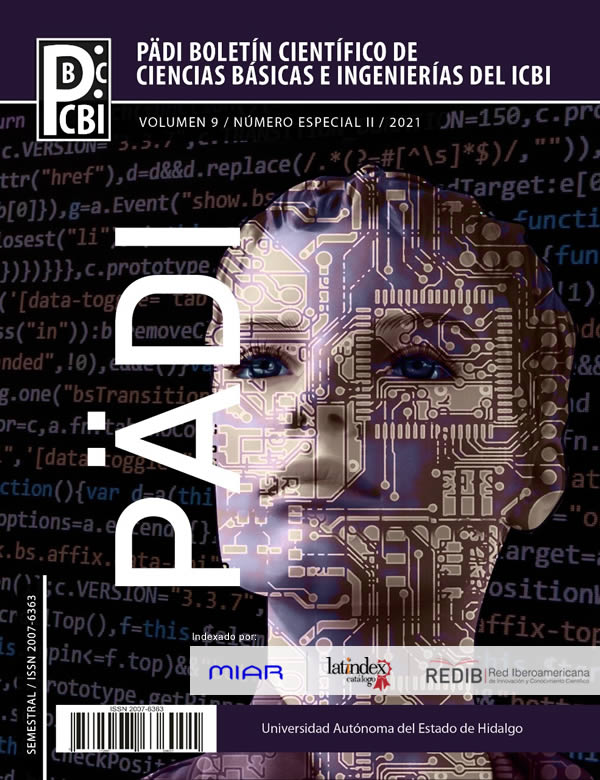Obtención de hidrogeles de quitosano/Rosmarinus officinalis modificados con plasma
DOI:
https://doi.org/10.29057/icbi.v9iEspecial2.8002Palabras clave:
Hidrogel, quitosano, hemólisis, plasma, biocompatibilidadResumen
Los hidrogeles son redes tridimensionales con gran contenido de agua, tienen diferentes propiedades de acuerdo al material con el que se obtengan. Estos materiales a base de polímeros naturales presentan propiedades de biocompatibilidad, biodegradabilidad, entre otras. Sin embargo, estas propiedades pueden mejorarse utilizando tecnología de plasma, el cual es un procedimiento con la capacidad de modificar superficies para funcionalizar, esterilizar o polimerizar un material. En el presente trabajo se obtuvieron hidrogeles a base de quitosano con diferentes concentraciones de ácido acético glacial, se caracterizaron por las técnicas FTIR-ATR, DSC y TGA. Para la evaluación de la biocompatibilidad, se realizó un ensayo hemolítico, y se comparó un blanco, contra un hidrogel con extracto de romero y otro hidrogel con extracto de romero y modificado con plasma. Los resultados obtenidos demostraron que la tecnología de plasma es una herramienta innovadora para mejorar propiedades biológicas al modificar superficies.
Descargas
Información de Publicación
Perfiles de revisores N/D
Declaraciones del autor
Indexado en
- Sociedad académica
- N/D
Citas
Ahmed, M. E., Mohamed, H. M., Mohamed, M. I., Kandile, N. G. (2020). "Sustainable antimicrobial modified chitosan and its nanoparticles hydrogels: Synthesis and characterization." International Journal of Biological Macromolecules 162: 1388-1397.
Ben Abada, M., et al. (2020). "Variations in chemotypes patterns of Tunisian Rosmarinus officinalis essential oils and applications for controlling the date moth Ectomyelois ceratoniae (Pyralidae)." South African Journal of Botany 128: 18-27.
Bonilla-Cruz, J., Lara-Ceniceros, T., Saldívar-Guerra, E., Jiménez-Regalado, E. (2007). "Towards Controlled Graft Polymerization of Poly[styrene-co-(maleic anhydride)] on Functionalized Silica Mediated by Oxoaminium Bromide Salt. Facile Synthetic Pathway Using Nitroxide Chemistry." Macromolecular Rapid Communications 28(13): 1397-1403.
Dhand, A. P., Galarraga, J. H., Burdick, J. A. (2020). "Enhancing Biopolymer Hydrogel Functionality through Interpenetrating Networks." Trends in Biotechnology.
Dong, Y., Wang, H., Ruan, Y., Zhao, Y. (2004). "Studies on glass transition temperature of chitosan with four techniques." Journal of Applied Polymer Science 93(4): 1553-1558.
Elmi, A., et al. (2019). "Antimicrobial capabilities of non-spermicidal concentrations of tea tree (Melaleuca alternifolia) and rosemary (Rosmarinus officinalis) essential oils on the liquid phase of refrigerated swine seminal doses." Research in Veterinary Science 127: 76-81.
Forouzandehdel, S., et al. (2020). "Synthesis of a novel magnetic starch-alginic acid-based biomaterial for drug delivery." Carbohydrate Research 487: 107889.
Karadağ, A. E., et al. (2019). "In vitro antibacterial, antioxidant, anti-inflammatory and analgesic evaluation of Rosmarinus officinalis L. flower extract fractions." South African Journal of Botany 125: 214-220.
Liu, Q., Xiong, L., Sun, Q., Ji, N. (2020). "Rapid gelling, self-healing, and fluorescence-responsive chitosan hydrogels formed by dynamic covalent crosslinking." Carbohydrate Polymers 246: 116586.
Lopez-Carrizales, M., et al. (2020). "Characterization, antibiofilm and biocompatibility properties of chitosan hydrogels loaded with silver nanoparticles and ampicillin: an alternative protection to central venous catheters." Colloids and Surfaces B: Biointerfaces 196: 111292.
Loto, R. T. and C. A. Loto (2019). "Data on the comparative evaluation of the corrosion inhibition of vanillin and vanillin admixed with rosmarinus officinalis on mild steel in dilute acid media." Chemical Data Collections 24: 100290.
Lu, T.-Y., Chen, Y., Huang, W. (2020). "Effect of varied hair protein fractions on the gel properties of keratin/chitosan hydrogels for the use in tissue engineering." Colloids and Surfaces B: Biointerfaces 195: 111258.
Maiz-Fernández, S., Guaresti, O., Pérez-Álvarez, L., Ruiz-Rubio, L., Gabilondo, N., Vila-Vilela, J. L., Lanceros-Méndez, S. (2020). "β-Glycerol phosphate/genipin chitosan hydrogels: A comparative study of their properties and diclofenac delivery." Carbohydrate Polymers 248: 116811.
Mucha, M. and A. Pawlak (2005). "Thermal analysis of chitosan and its blends." Thermochimica Acta 427(1): 69-76.
Rezaei, F. S., Sharifianjazi, F., Esmaeilkhanian, A., Salehi, E. (2021). "Chitosan films and scaffolds for regenerative medicine applications: A review." Carbohydrate Polymers 273: 118631.
Tran, D. L. (2020). "Novel enzymatically crosslinked chitosan hydrogels with free-radical-scavenging property and promoted cellular behaviors under hyperglycemia." Progress in Natural Science: Materials International.
Wei, W., Yuanzhu, M., Xudong, Y., Wenyan, Z., Xiaozhao W., Chenglin, L., Junxin, L., Qiulin, H., Sebastian, L., Hongwei, O. (2021). "Advanced hydrogels for the repair of cartilage defects and regeneration." Bioactive Materials 6(4): 998-1011.
Zhong, X., et al. (2020). "Chemical characterization of the polar antibacterial fraction of the ethanol extract from Rosmarinus officinalis." Food Chemistry: 128674.




















